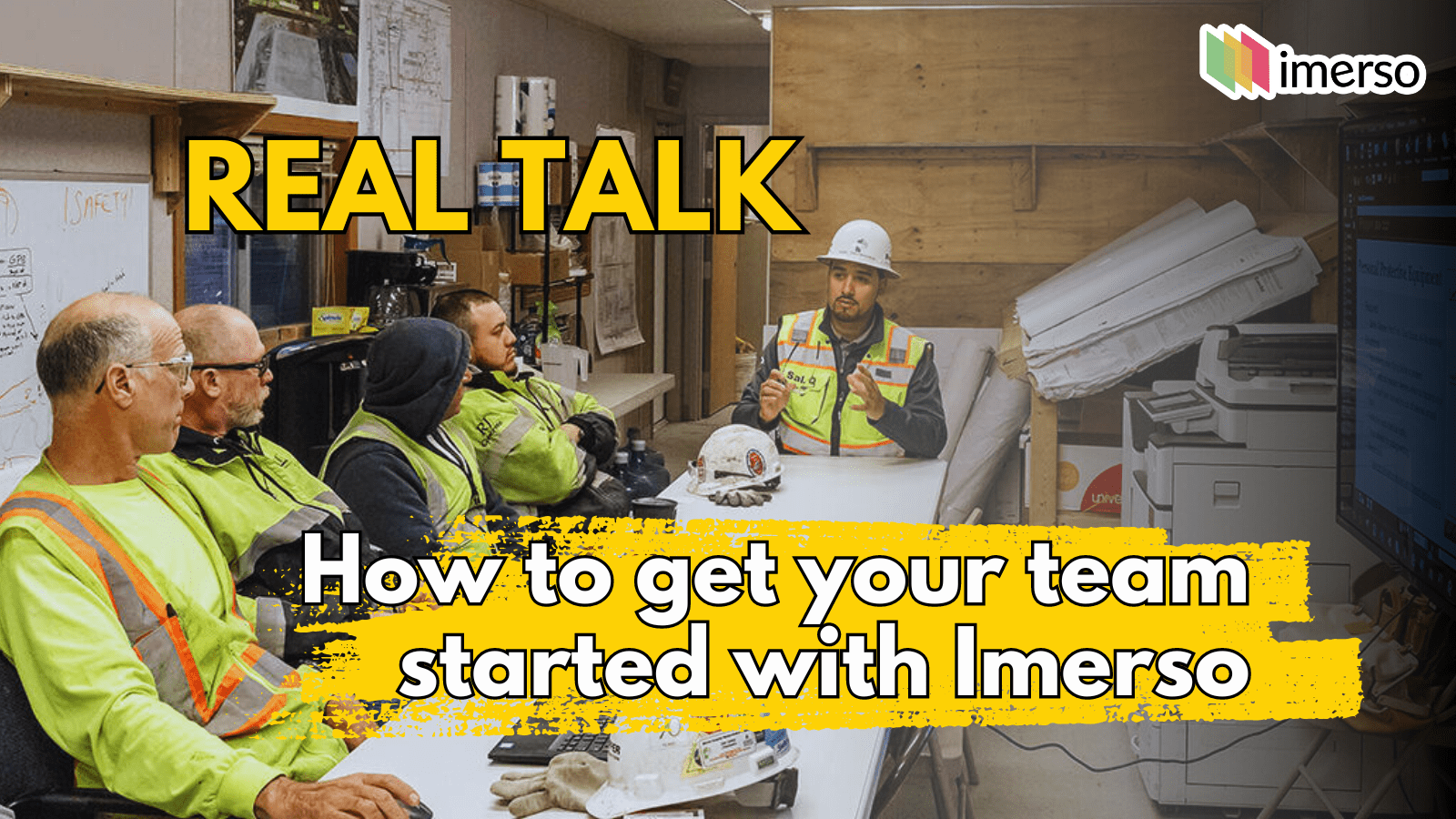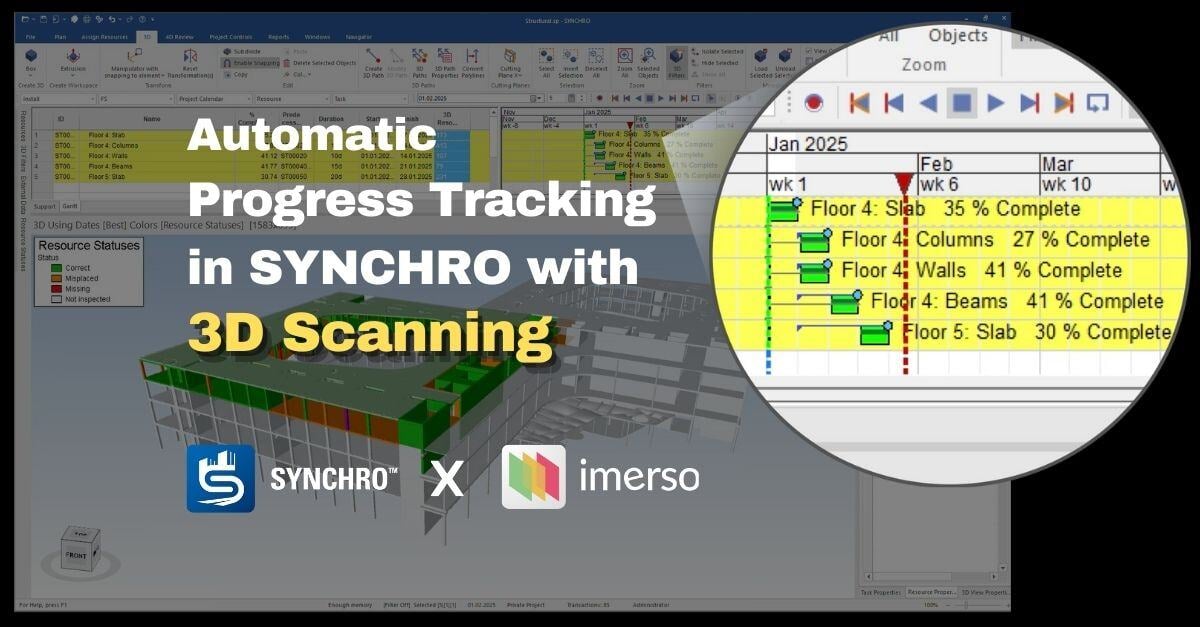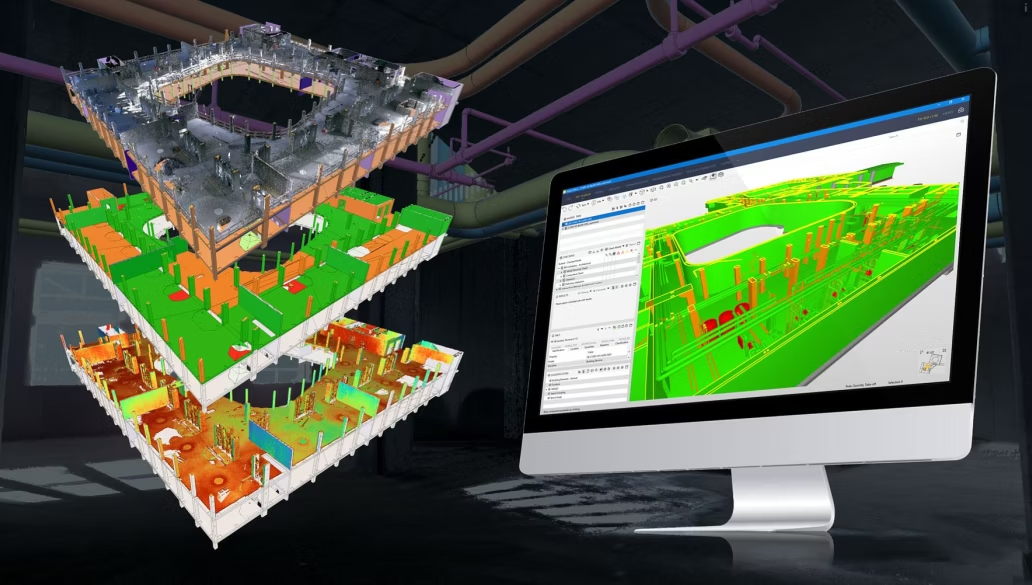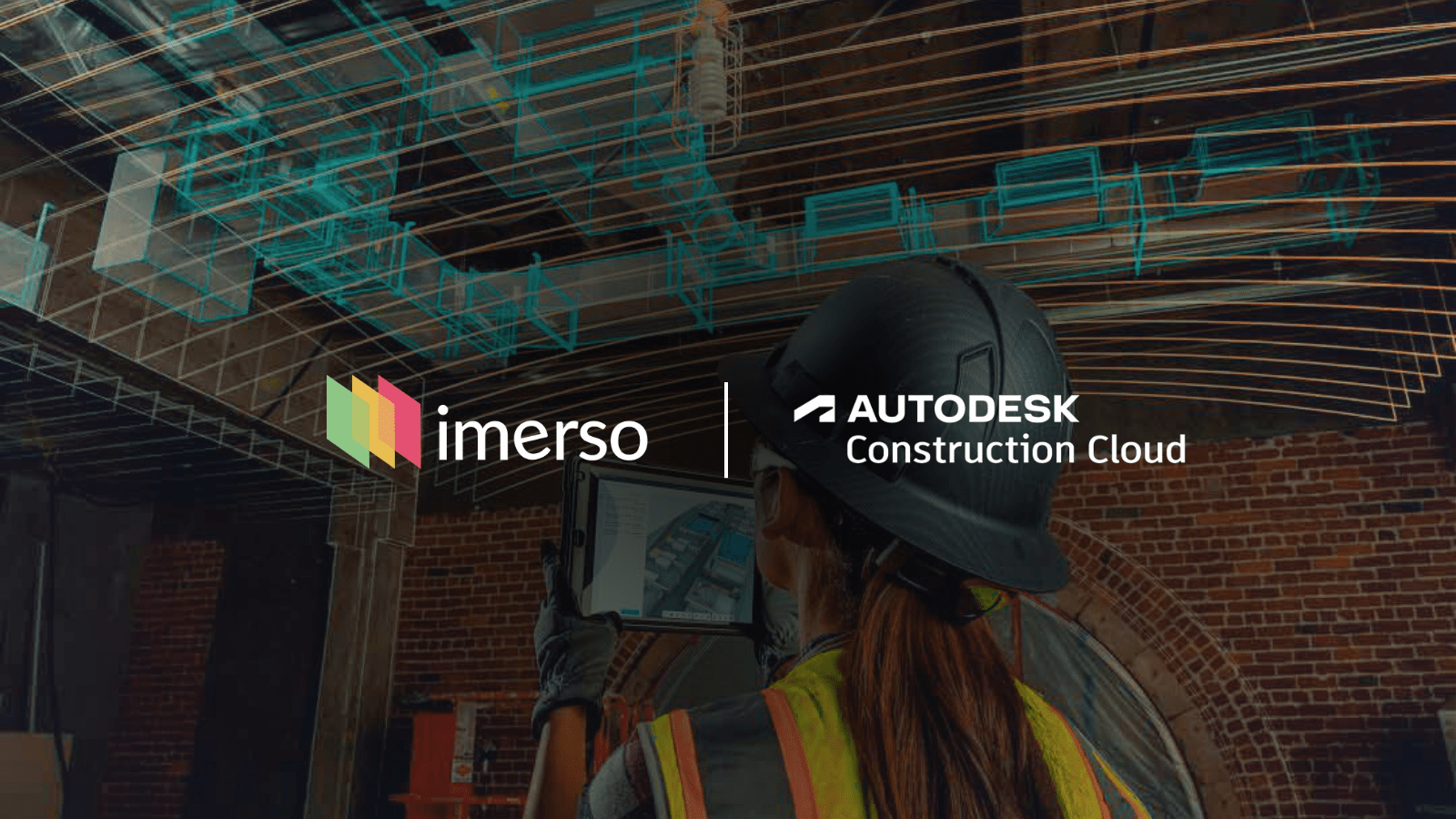Content
Another tech platform?? I don't want to deal with that...
Who will actually do the Imerso tasks? We can't afford extra resources.
We need to find the right project for this.
But we already track the site with 360 Cameras. Why change?
We'd need a laser scanner for this. It's too expensive for our budget.
We need to know the ROI. We must first create a business case.
It often goes something like this:
I’m already sold… You don’t need to tell me anymore, I get it.
|
This is the #1 complaint we hear from prospective customers about to start their Imerso journey.
Modernising the notoriously lagging construction industry requires true believers: Patient champions of “working smarter, not harder” that tirelessly fight the battle between innovation and resistance to change.
This article is about understanding that innovation is not solely about groundbreaking new tech, but also (and most of all) about effective implementation. In this post we want to support all innovation champions in our industry for pushing the boundaries towards more efficient and rewarding ways of working in construction.
Let’s address common pushbacks and misconceptions when introducing Imerso as a new construction project management tool. Here we go!
Another tech platform?!
I don’t want to deal with that.
 Many of the teams we meet have recently begun their digital transformation journey. One of the common trends is the recent roll out of a Common Data Environment (CDE) platform like Autodesk ACC, StreamBIM, CatendaHUB, Procore, or Dalux, aimed to digitise and standardize the way teams collect and share information in construction projects.
Many of the teams we meet have recently begun their digital transformation journey. One of the common trends is the recent roll out of a Common Data Environment (CDE) platform like Autodesk ACC, StreamBIM, CatendaHUB, Procore, or Dalux, aimed to digitise and standardize the way teams collect and share information in construction projects.
This is a lengthy process, as whatever platform you ultimately choose will require getting all team members onboard and providing training to everyone so they can become proficient. For many, this is a respectful amount of effort and a big step into the digital realm.
There may well be still some fatigue with such new (and perhaps still ongoing) learnings. The thought of having to go through the same effort yet again for a new platform is likely to put some people off. Team leaders will instinctively argue on the need for it, and whether the benefit outweighs the effort.
So if you’ve presented Imerso to your team as a new opportunity, but received a rather flat response, this can be one of the reasons. If that’s the case, try to clarify some important points:
- Don't worry about re-training the entire team:
Imerso only requires 1-2 active users, not the entire onsite team. - Don’t worry about lengthy tech rollouts:
Your project can be up and running in less than 3 days. Training typically takes only two hours for anyone familiar with BIM, and you’re ready to roll. - Don’t worry about resource allocation and labour costs:
Usage of only a couple hours per week is all it takes to be successful, while simultaneously removing other outdated workflows that used to waste lots of time (bottomline, it actually saves time for the users themselves.) - PS: Also, let’s clarify just in case: Imerso is not a CDE.
Our platform integrates with popular CDE products, and it is not meant to replace them. So whatever software tools your team is using, no need to worry about changing those. Imerso's data will rather make them better.
These should placate this kind of reaction from the more tech-fatigued team leaders.
But we suspect you are not out of the woods yet…
Who will actually do the Imerso tasks?
We can't afford extra resources…
 Sometimes the mere mention of 3D Laser Scanning strikes fear and conjures images of scarce expert resources, or expensive 3rd party services.
Sometimes the mere mention of 3D Laser Scanning strikes fear and conjures images of scarce expert resources, or expensive 3rd party services.
And you say the site scanning will be done on a weekly basis, or so?? How can that possible be feasible..?
We can't afford to allocate more resources to such additional tasks…
Relax.
Imerso was made specifically to make 3D Laser Scanning easy and affordable, as a simple routine that any team member can do entirely by themselves. This brings many benefits your team might not have realised.
To use Imerso you don’t need more than a few hours per week from anyone in your team:
- Ideally your main user has some familiarity with BIM and understanding of the main work schedules of your project.
- Onsite scanning tasks are so easy they can be delegated to interns or students, for 1-2 hours per week. They don't need to scan the entire jobsite every time, but just the areas that have recently been worked on or been concluded.
- Data analysis is automated by Imerso: Users simply need to review results and push the relevant cases to the project’s CDE. This can also be delegated to a junior staff or a student.
- You will not be adding workload to your team on top of existing tasks:
Imerso will accelerate several tasks, while entirely removing the need for others, so in the end your team will be spending much less time on pointless work and more on value-adding tasks.
All of this is covered during the Onboarding period included for free in every Imerso subscription.
Alternatively, you can of course use trained or outsourced resources to handle the onsite scanning or data analysis for you. Imerso supports any option.
We need to find the right project for this.
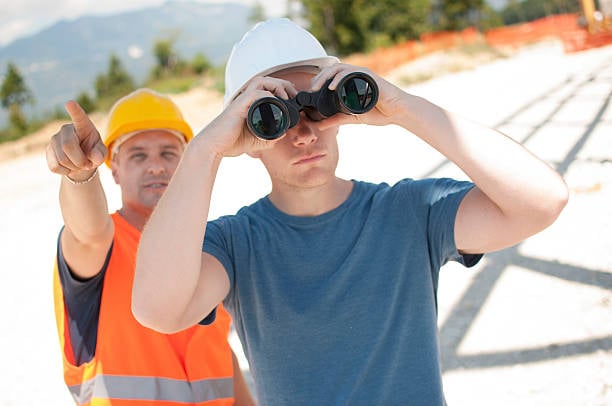 It's a fair point and sounds like a step in the right direction, but this is often used to postpone making a decision.
It's a fair point and sounds like a step in the right direction, but this is often used to postpone making a decision.
The truth is that using Imerso does not require any special specifications in term of the type of project: it can be used in any jobsite, from short office refurbishments, to multi-year mega-projects. It can also be deployed at any construction phase, whether the early excavation and structural foundation, to latter technical services installations.
It's true that the value is bigger in larger projects, simply because there is a wider surface area to prevent things from going wrong. Likewise, the value of starting in earlier stages is higher, simply because that's where the mitigation impact is also biggest. Nonetheless, our customers also have projects that aren't especially big or complex, which still are benefiting highly from frequent, objective control routines with Imerso.
So the type of project and timing is not really the biggest factor.
Our recommendation: The most important thing, trumping all the above, is to find an engaged and forward-oriented team, excited to give this a proper go and explore the opportunity — regardless of the type of the project and the work timing.
If you have a team excited to try Imerso and wants to become its innovation champion: That is the single biggest success factor in our experience.
But we already track the site with 360 Cameras. Why change?
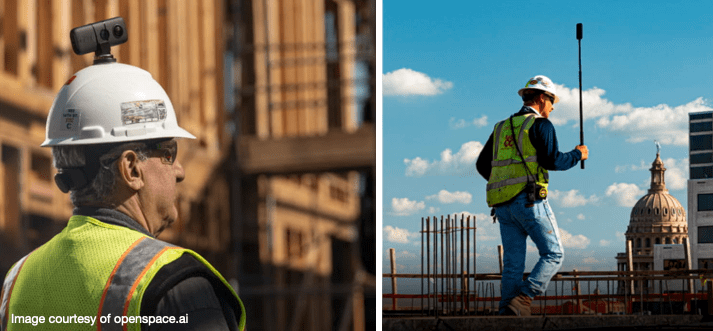 You don’t need to change one for the other, these are different things. The two approaches have different purposes and achieve different results. Read more on the advantages and disadvantages of 360 Cameras vs. 3D Laser Scanning for Construction Management.
You don’t need to change one for the other, these are different things. The two approaches have different purposes and achieve different results. Read more on the advantages and disadvantages of 360 Cameras vs. 3D Laser Scanning for Construction Management.
Essentially, 360 Cameras create 2D images that are great for keeping tabs on work progress. Put a camera on a helmet, walk around and have a look if all relevant objects are built onsite. BUT images do not contain 3D data or measurements. So while you know whether a planned object is present onsite, you don’t know if it has been installed correctly per the planned specs, in the right place and tolerance. This information you will only get with a 3D point cloud that comes from a laser scanner.
Completed work is not the same as Correctly Completed Work.
Take the example below: In the first image you can see the BIM plans next to the onsite reality captured in a 360 image. All looks completed as per the models. What you are missing (which you can only detect in the bottom image, using 3D scan data) is a severe misplacement and out-of-tolerance tilt in this load bearing structural column. Measurements matter.
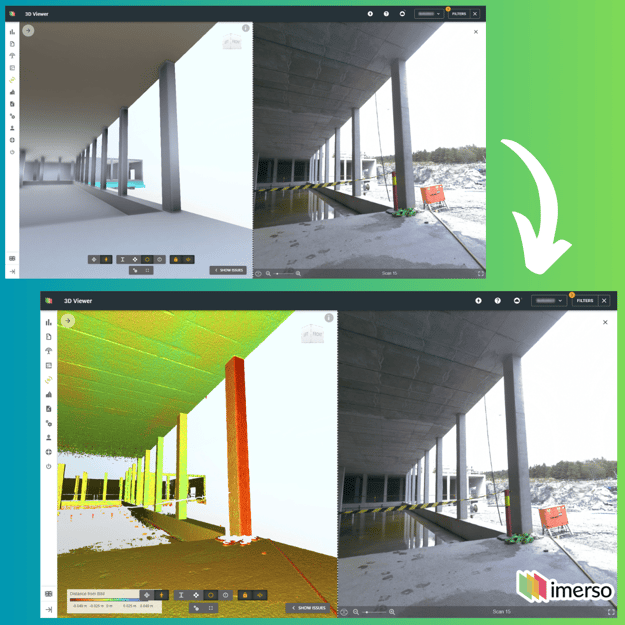 There are countless similar examples where problematic work deviations remain hidden in visual data. The truth is that there is no need to replace existing 360 Camera approaches with Laser Scanning, but without scan routines the project is left with dangerous blindspots. Both approaches are beneficial to construction management and we see many customers use both methods in parallel, building on each other's strengths.
There are countless similar examples where problematic work deviations remain hidden in visual data. The truth is that there is no need to replace existing 360 Camera approaches with Laser Scanning, but without scan routines the project is left with dangerous blindspots. Both approaches are beneficial to construction management and we see many customers use both methods in parallel, building on each other's strengths.
We would need a laser scanner for this.
It's too expensive for our budget.
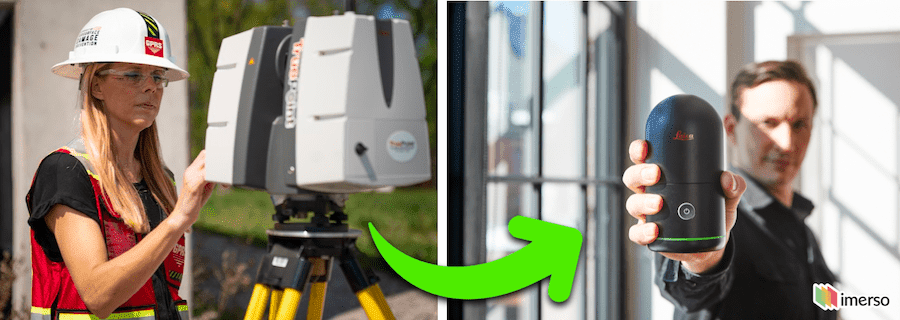 Yes, your team will need a laser scanner to use Imerso. You cant get accurate As-built data without.
Yes, your team will need a laser scanner to use Imerso. You cant get accurate As-built data without.
Yes, a scanner is more expensive than a measuring tape... It also gives much more information.
Remember: a scanner is still way less expensive than a single case needing rework or delay costs.
To get your hands on one, you have several options here:
Purchasing a scanner
Your team can choose from a variety of models in the market, giving you a range of prices depending on the specs you need. The prices for a decent 3D scanner has been going down to €10.-20.000, while being much faster and easier to use than just a couple of years ago. For medium and large projects, this expense is pocket money compared to the benefits, but it may be a too large expense for smaller, short-term projects.
Renting / Leasing a scanner
If struggling to make the upfront commitment or finding the financing, local dealers often offer short-term rental options. This lets your team test the device for a few weeks before pulling the trigger. Depending on the project needs, some of our customers are scanning their sites less frequently (1-2 per month, instead of weekly), for which they have arranged custom rental arrangements with local vendors. Most vendors also offer lease agreements where the equipment is paid over time as a rental, but with the choice of getting to keep and own the device at the end of the payment period.
Internal Procurement
Depending on your type of business, some companies have in-house surveying departments (typically responsible for surveying and 3D scanning a property or jobsite, and returning a 3D BIM model). The actual onsite scanning task is the fastest (most of their time is spent on modeling). This leaves 3D Laser Scanners idle on the shelf, getting dust. We’ve seen teams arranging with their surveyor colleagues to make any idle devices available to the site team for Imerso scanning – It’s just a matter of coordination and being resourceful.
External service providers
You can also leverage external parties that specialise in 3D Scanning and can deliver the scans right into Imerso for you. Some of these services can also use Imerso and push detected issues directly into your CDE. This allows you to get some extra resources on your project.
And for budgeting
Our customers are estimating an average cost saving above €13-15.000 per jobsite issue detected by Imerso. With several hundreds of detections in a typical project, the scanner device is sure to pay for itself after the first weeks of use. Ultimately, if the budget for a laser scanner is not allocated to that expense, it’s not like it will be saved. Rather, the same amount or more will be allocated to some other expense, likely with much lower return on investment.
We need to know the ROI.
We must first create a business case.
 Fair point, but often often used to postpone making a decision. There's no need to make a PhD thesis out of this, let’s keep it simple.
Fair point, but often often used to postpone making a decision. There's no need to make a PhD thesis out of this, let’s keep it simple.
We recommend that your team outline the current methods your projects typically use to keep tabs on what’s going on at the jobsite. What processes do your teams use to ensure that everything is being built according to the planned specifications?
Chances are you're using inefficient quality tracking methods like photos, checklist apps, and manual spot-checks at the site. The data documented by these approaches is only visual and heavily subjective. Measurements and geometries are missing, while only capturing a small sample of everything built at the site. This leads to substantial costs of rework, delays, disputes, travels to the site, and idle waiting time.
Comparing Imerso to traditional approaches of site supervision, our customers found a 15x growth in efficiency at monitoring the site status, using only 10% of the resources while capturing much higher data quality. The NHN Hospital project in Denmark found that one team leader achieved in only 2 months a year’s work of an entire team. We’ve shared case-studies from several customers who estimated cost-savings above 2% of their construction budget in the first 16 months with Imerso, and capital returns over 38x times their fully-loaded investment (software + scanning devices + users’ labor time). We’ve seen champions demonstrating the business case for Imerso to other team leaders in their companies using a mere 3 or so example detections of construction issues from their site. With a typical project often seeing hundreds of detections, it’s often the case that a positive ROI is achieved within weeks. Sometimes, even the prevention of a single severe construction issue justifies the Imerso investment many times over.
You can also consider Cost of Inactivity (or Cost of Indecision - COI). While many know about ROI, this is the exact opposite of that. There is nothing that costs more than inactivity, the cost of not doing that thing that would benefit you. Try to get an understanding on: How many hours per week are your teams collectively using on monitoring the jobsite, capturing As-built information and measurements, inspecting completed works, waiting for site information to communicate and resolve issues, and updating BIM models to onsite changes? How expensive are your processes today and how much longer can you afford not to do anything about it?
Wrapping up: The real question.
The reality is that for all of our most successful customers, the business-case for Imerso was obvious from the get-go. The technology must benefit the users and make their lives easier, so ultimately it needs to be experienced in real-life as many things cannot be expressed in calculations.
So the question is: Are the potential rewards larger than any real risk here?
Wasting the price of a laser scanner? Avoiding a single work issue can easily return that capital manifold... Imerso is reporting hundreds of cases left overlooked by alternative methods (so that option is in fact much more costly to the project).
Distracting your team with learning a new software tool? A single scan-inspection report will return that effort manifold. You'll not manage to produce the same As-built documentation of equal m2 area coverage, at the same detail and accuracy, produce updated BIM models to the current site status, detect out-of-tolerance work, and communicate site status so easily across your teams, with less time and workload than using Imerso.
Danger of replacing established workflows with something new? Imerso can initially run on top of your current processes like an add-on. However, after using the technology for a few weeks, many clients realise how many processes they are able to replace and as a result streamline their construction workflow.
If your team sees no need to change the status quo, then obviously there is no argument to do anything new. But that is why we made Imerso so intuitive that anyone can learn in two hours, scans are matched automatically to the BIM models, and people don’t need to wander around days onsite taking photos or random control spot-checks.
If that sounds good to you, we can help you have Imerso up and running in your project in under 3 days! Let's talk!

.png?width=350&height=147&name=Imerso_Logo_A4_White_Transp%201%20(1).png)
